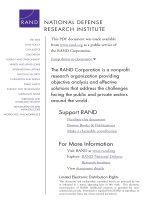Slides – Accounting Intake 52
Bạn đang xem bản rút gọn của tài liệu. Xem và tải ngay bản đầy đủ của tài liệu tại đây (2.25 MB, 17 trang )
<span class='text_page_counter'>(1)</span><div class='page_container' data-page=1>
<i><b>Copyright © 2009 by The McGraw-Hill Companies, Inc. All rights reserved.</b></i>
<i><b>McGraw-Hill/Irwin</b></i>
<b>Statement </b>
<b>Analysis</b>
</div>
<span class='text_page_counter'>(2)</span><div class='page_container' data-page=2>
10
<b>CHAPTER</b>
</div>
<span class='text_page_counter'>(3)</span><div class='page_container' data-page=3>
Credit analysis
<b>Liquidity </b>
• A company’s ability to
meet short-term
obligations.
– Are the company’s current
assets adequate to its
current liabilities?
– How long is the company’s
operating cycle?
– How much of cash does
the company generate from
operations?
<b>Solvency</b>
• A company’s ability to
meet long-term
obligations.
– What is the company’s
capital structure?
</div>
<span class='text_page_counter'>(4)</span><div class='page_container' data-page=4>
<b>Liquidity analysis</b>
Current ratio
Current assets
Current liabilities
=
Working capital = Current assets – Current liabilities
Quick ratio
Cash & Cash equivalents + Marketable
securities + Accounts receivable
Current liabilities
=
Cash-to-current
liabilities ratio
Cash & cash equivalents + marketable securities
Current liabilities
=
Cash-to-current
assets ratio
Cash & cash equivalents + marketable securities
Current assets
</div>
<span class='text_page_counter'>(5)</span><div class='page_container' data-page=5>
<b>As at 31/12/2011</b> <b>VCS DAC</b> <b>HPS</b>
<b>1</b> Current ratio 0,91 1,19 4,06
<b>2</b> Quick ratio 0,19 0,60 3,04
</div>
<span class='text_page_counter'>(6)</span><div class='page_container' data-page=6>
<b>Liquidity analysis</b>
Cash flow ratio
Operating cash flow
Current liabilities
=
Cash-to-maturing
debt ratio
Operating cash flow
Maturing debts
=
</div>
<span class='text_page_counter'>(7)</span><div class='page_container' data-page=7>
<b>For the year ended Dec. 31, 2011</b> <b>VCS</b> <b>DAC</b> <b>HPS</b>
(in VND mil.)
<b>1</b> Current liabilities at year end 1,047,892 18,523 4,102
<b>2</b> Maturing debts at year end 755,232 8,694
<b>-3</b> Net cash flows form operating
activities
(163,851) (7,546) 1,711
<b>4</b> Cash flow ratio -0.16 -0.41 0.42
</div>
<span class='text_page_counter'>(8)</span><div class='page_container' data-page=8>
<b>Liquidity analysis</b>
Purchasing Payments for purchasing <sub>Selling Collecting money from selling</sub>
Payment
period
Days to sell inventory <sub>Collection </sub>
period
</div>
<span class='text_page_counter'>(9)</span><div class='page_container' data-page=9>
Operating
cycle
<b>=</b>
Days to sell
inventory
+
Collection
period
-
Payment
period
</div>
<span class='text_page_counter'>(10)</span><div class='page_container' data-page=10>
Days to sell
inventory <sub>360</sub>
Cost of goods sold
=
<b>Liquidity analysis</b>
Average inventory
÷
Collection
period
360
Sales
= Average account
receivables
÷
Payment
period
360
Cost of goods sold
= Average account
</div>
<span class='text_page_counter'>(11)</span><div class='page_container' data-page=11>
Days to sell
inventory <sub>360</sub>
Cost of goods sold
=
<b>Liquidity analysis</b>
Average inventory
÷
Collection
period
360
Sales
= Average account
receivables
÷
Payment
period
360
Cost of goods sold
</div>
<span class='text_page_counter'>(12)</span><div class='page_container' data-page=12>
Inventory
turnover
Cost of goods sold
Average inventory
=
<b>Liquidity analysis</b>
Accounts receivable
turnover
Sales
Average accounts
receivable
=
Accounts payable
turnover
Cost of goods sold
Average accounts
</div>
<span class='text_page_counter'>(13)</span><div class='page_container' data-page=13></div>
<span class='text_page_counter'>(14)</span><div class='page_container' data-page=14></div>
<span class='text_page_counter'>(15)</span><div class='page_container' data-page=15>
Total debt-to-equity
capital ratio
Total liabilities
Shareholders’ equity
=
Total debt ratio
(total
debt-to-total capital ratio)
Total liabilities
Total capital
=
Debt-to-equity ratio
(Long-term debt to
equity capital ratio)
Long-term debt
Shareholders’ equity
=
</div>
<span class='text_page_counter'>(16)</span><div class='page_container' data-page=16></div>
<span class='text_page_counter'>(17)</span><div class='page_container' data-page=17>
Time interest
earned ratio
EBIT
Interest expense
=
<b>Solvency analysis</b>
Earnings to fixed
charges ratio
Earnings available for fixed charges
Fixed charges
=
Earnings available for fixed charges:
• Pretax income from continuing operations
• Interest incurred (both expensed and
capitalized)
</div>
<!--links-->









